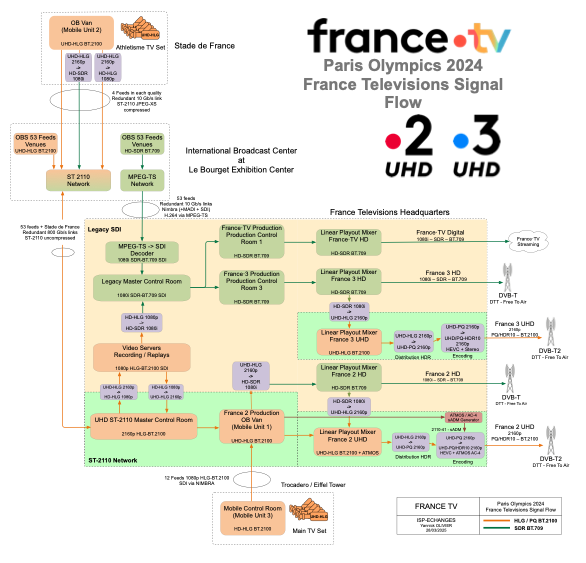Thierry Fautier had the privilege of being invited by Yannick Olivier of France TV to visit the broadcaster’s facilities in Paris during the recent Summer Olympic Games, broadening our understanding of what it takes to broadcast a UHD channel 24/7 for more than two weeks consecutively.
First, though, some definitions are a necessary housekeeping task. According to the Ultra HD Forum, Ultra HD can be either 1080p with HDR, or UHD 2160p SDR, or 2160p HDR.
Although we have seen events like UEFA Euro 2024 produced in 1080p HDR, OBS (Olympic Broadcasting Services), which produces the Olympics, decided to produce the Olympic Games in 2160p HDR, with 88% of the events covered in native UHD.
Given the worldwide nature of the Olympics, the majority of broadcast channels are still in HD, with some still in SD. The host broadcaster, OBS, produced two output formats: 2160p HDR (HLG) and 1080i SDR. For the past several Olympics, the host HDR production used the HLG-HDR signal format, while the SDR signal format is derived from the core HDR production format using a LUT (Look-Up Table).
The Olympic live events were locally produced, using either traditional OB vans or through virtualized remote production (REMI) at different venues (35 in total were counted) that sent signals to the IBC (International Broadcast Center), which then dispatched them to various distributors, including France TV, the rights holder for France.
France TV also had its own studios, where shows were produced in HD SDR and HDR, along with contributions from fan zones. These areas, set up around Paris, allowed the public to watch live events and replays, as well as participate in themed activities.
France TV’s downstream HLG production is converted to PQ for transmission to customers (see Figure 1 below)
The challenge for France TV was to take some 53 live UHD feeds at 800 Gbps and create two live channels: France 2 UHD, which was native UHD (using a brand-new UHD facility), and France 3 UHD, which was produced in HD and upconverted to UHD (due to budget and time constraints).
The first essential element is that production relied on a dual infrastructure at France TV: HD programming using the SDI signal format and using the ST 2110 signal format.
The feeds received from OBS were in the following formats:
- 1 x ST-2110-20 video UHD stream (2160/50p/HLG)
- 3 x ST-2110-30 audio (Stereo international audio + 5.1 inter + 5.1.4 inter)
- 1 x ST-2110-40 ancillary data stream
The audio programs provided by the host broadcaster included a stereo international mix, a 5.1 surround mix of the global audio program, and a 5.1+4 (overhead) immersive audio program. France TV, using Dolby AC-4, provided four different presentations: French dialog, Audio Description, Hearing Impaired, and No Commentary. These were made up of a Music and Effects (M&E) bed of the international sound program along with two dialog tracks, French and Audio Description. To enable this workflow, France TV adopted an MGA (Metadata Guided Audio) approach using Serial ADM (Audio Definition Model) that allowed for the transport of audio metadata via ST2110-41 along with the audio channel data via ST2110-30. The audio workflow was supported by a combination of Calrec audio mixer, Junger AIXpresser for the S-ADM authoring and rendering and Trinnov 5.1.4 monitoring.
France TV had a remote OB van at the Stade de France, producing content in 2160p UHD HDR, which was delivered to the IBC using JPEG-XS compression, providing low-latency, mezzanine-compressed video at 10Gb/s.
Once the feeds were received, they were always recorded in 1080p HLG format due to the storage size and costs that 2160p recording would have required.
The France TV UHD deployment was on-premises, with some devices using COTS equipment, while others are bespoke equipment. The France TV roadmap aims for a 100% COTS-based system that could eventually migrate to any data center location.
The ad workflow design utilized the UHD playout server to switch between the UHD native program and the ad, which originated from the HD channel and was upconverted to UHD. This switch appeared seamless to the end device.
France TV UHD channels (France 2 UHD and France 3 UHD) on DTT were output at a constant bitrate at 15 Mbps per channel using HEVC encoding. Additionally, France TV UHD channels (France 2 UHD and France 3 UHD) were natively encoded with HEVC for IPTV at 20 Mbps in Constant Bit Rate (CBR) mode.
France TV’s lead engineer, Yannick Olivier, said about the project: “My feeling about this colossal project is that, first of all, technical excellence still exists and must continue to advance our industry. Also, having had the opportunity to achieve this thanks to the Olympic Games demonstrated internally that what might have seemed impossible to people was actually possible without too much difficulty.”
In terms of audience, France TV reported that during the opening ceremony, there were 24 million viewers (as measured), with 1 million watching a UHD program, representing 4% of the audience even though little communication was made to educate the public to switch to channel 52 (UHD) instead of channel 2 (HD), which viewers had been using for their entire lives.

Figure 1 France TV Paris Olympics Signal Flow[1]
[1] Drawing courtesy of Yannik Olivier, France TV
Post courtesy Thierry Fautier, Ultra HD Forum President Emeritus.
